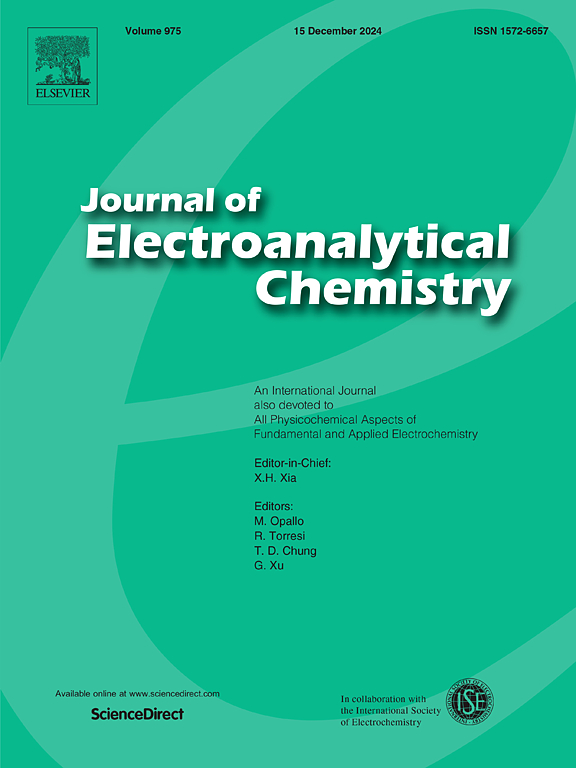Mo/VONC作为多硫化物固定剂和催化剂提高锂硫电池性能
IF 4.1
3区 化学
Q1 CHEMISTRY, ANALYTICAL
引用次数: 0
摘要
多硫化物的溶解和硫的缓慢转化反应是阻碍锂硫电池电化学性能的重大挑战。为了解决这些问题,我们开发了Mo/VONC,这是一种源自钼掺杂钒基金属有机框架(MOFs)的材料,它既可以作为多硫化锂(LiPS)的固定化剂,也可以作为催化剂。Mo/VONC独特的“稻花棒”形态有助于增强电解质渗透和锂离子(Li+)扩散。此外,钼(Mo)的掺杂加速了Li2S的成核和液固转变,从而改善了充放电过程中硫种转变的动力学。这有效地减轻了穿梭效应,提高了骑行性能。含有Mo/VONC的锂离子电池表现出优异的电化学性能,在0.5C下循环200次后,容量保持在564 mAh/g(容量保持率为82.8%)。本文章由计算机程序翻译,如有差异,请以英文原文为准。
Mo/VONC as a polysulfide immobilizer and catalyst to enhance performance of Lithium sulfur batteries
The dissolution of polysulfides and the slow conversion reactions of sulfur species represent significant challenges that impede the electrochemical performance of lithium‑sulfur (Li![]() S) batteries. To address these issues, we have developed Mo/VONC, a material derived from molybdenum-doped vanadium-based metal-organic frameworks (MOFs), which serves as both a lithium polysulfide (LiPS) immobilizer and a catalyst. The distinctive “rice-flower rod” morphology of Mo/VONC facilitates enhanced electrolyte penetration and lithium-ion (Li+) diffusion. Furthermore, molybdenum (Mo) doping accelerates Li2S nucleation and the liquid-solid transition, thereby improving the kinetics of sulfur species transition during the charging and discharging processes. This effectively mitigates the shuttle effect and enhances cycling performance. Li
S) batteries. To address these issues, we have developed Mo/VONC, a material derived from molybdenum-doped vanadium-based metal-organic frameworks (MOFs), which serves as both a lithium polysulfide (LiPS) immobilizer and a catalyst. The distinctive “rice-flower rod” morphology of Mo/VONC facilitates enhanced electrolyte penetration and lithium-ion (Li+) diffusion. Furthermore, molybdenum (Mo) doping accelerates Li2S nucleation and the liquid-solid transition, thereby improving the kinetics of sulfur species transition during the charging and discharging processes. This effectively mitigates the shuttle effect and enhances cycling performance. Li![]() S batteries incorporating Mo/VONC exhibit superior electrochemical performance, retaining a capacity of 564 mAh/g after 200 cycles at 0.5C (82.8 % capacity retention).
S batteries incorporating Mo/VONC exhibit superior electrochemical performance, retaining a capacity of 564 mAh/g after 200 cycles at 0.5C (82.8 % capacity retention).
求助全文
通过发布文献求助,成功后即可免费获取论文全文。
去求助
来源期刊
CiteScore
7.80
自引率
6.70%
发文量
912
审稿时长
2.4 months
期刊介绍:
The Journal of Electroanalytical Chemistry is the foremost international journal devoted to the interdisciplinary subject of electrochemistry in all its aspects, theoretical as well as applied.
Electrochemistry is a wide ranging area that is in a state of continuous evolution. Rather than compiling a long list of topics covered by the Journal, the editors would like to draw particular attention to the key issues of novelty, topicality and quality. Papers should present new and interesting electrochemical science in a way that is accessible to the reader. The presentation and discussion should be at a level that is consistent with the international status of the Journal. Reports describing the application of well-established techniques to problems that are essentially technical will not be accepted. Similarly, papers that report observations but fail to provide adequate interpretation will be rejected by the Editors. Papers dealing with technical electrochemistry should be submitted to other specialist journals unless the authors can show that their work provides substantially new insights into electrochemical processes.

 求助内容:
求助内容: 应助结果提醒方式:
应助结果提醒方式:


